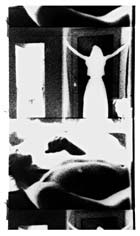original gauge :
distribution gauge :
distributed by :

18 min 20 sec
35mm
16mm
Sixpack Film (Vienna)
Light Cone (Paris)
Canyon Cinema (San Francisco)
Film-Makers' Coop (New York)
In 1985, I came up with the concept for a film which was to be produced with a photo camera. I can no longer remember when I first noticed that the size of a 35mm miniature negative is exactly the size of two film frames. For my film "Manufraktur" in 1985 I was still using some sequences of serial photographic pictures. In the following years I made further trial pictures for a film which was to be produced solely in the photo camera and which was meant to reflect this method of production.
I have, after all, been working on "Parallel Space: Inter-View" since 1988. Originally there was a strict, formal concept. The space of the Renaissance locked in the optics of the film and photo camera. Our eye, in front of which the landscapes of the film spread out and let themselves be conquered. The conception of an up-to-date subject, the subject of the modern, marking out its innerwordly position. And the subversion of this constellation by letting the hardware and the software slip a little bit. If I take a spatial photograph with strict central perspective where the vanishing point is in the middle, it gets smashed when projected. The spatial lines plunge towards the lower edge of the one frame to then be ripped apart at the top of the next. Optically it resembles a flickering double-exposure; the former temporal and spatial unity disintegrates into pieces which then start corresponding with each other. It then closes itself up again and regains its own entity. But soon these spatial constructions were not enough for me. I began to interpret both spatial halves with regard to content, namely to transport the viewer`s seperation from the surrounding reality, into a row of further binary opposites: listener – speaker, seer – seen, private – public, man – woman, child – grown up, sensuality/emotion – reason, sexuality – taboo, active – passive and so on. To this I took the setting of psychoanalysis to compare it with that of the cinema. In both cases there is the narrator who does not know or see his listeners. Film makers like analysand produce a very intimate flow of pictures which are met with a highly concentrated reception and still fall into the anonymity of the audience...
Peter Tscherkassky
taken from: Amy Taubin, "Flash Floods: Parallel
Space: Inter-View"
a grant from the Federal Ministry for the Arts.
Parallel Space: Inter-View was shown at the following festivals:
Viennale ‘92 (Austria) 1992
Forum 92, Bratislava (Tschechien) 1992
ARCO III Week of Experimental Cinema, Madrid (E) 1993
Mediawave, Györ (H) 1993
Int. Kurzfilmtage Oberhausen (D), Int. Wettbewerb, 1993
42nd Melbourne International Film Festival (AUS) 1993
No Budget-Filmfestival Hamburg (D) 1993
40. Sydney Film Festival (AUS) 1993
44. Mostra Int. di Montecatini Terme (I) 1993
VIPER, Luzern (CH) 1993
European Media Art Festival, Osnabrück (D) 1993
Int. Audio Experimental Festival/Arnhem (NL) 1993
Cinevideo Karlsruhe (D) 1993
London Film Festival (GB) 1993
New York Expo of Short Film and Video (USA) 1993
Diagonale, Festival des österreichischen Films (A) 1993
Aix-en-Provence (F) 1993
7. Stuttgarter Filmwinter (D) 1994
Istanbul – Int. Kurzfilmtage (TR) 1994
Ann Arbor Film Festival (USA) 1994
Big Muddy Film & Video Festival (USA) 1994
Impakt Utrecht (NL) 1994
New Visions, Glasgow (GB) 1994
Onion City Film Festival, Chicago (USA) 1994
Festival Internacional de Cinema, Figueira da Foz (Portugal) 1994
Image Forum Festival, Tokyo (Japan) 1994
17th Denver Int. Film Festival (USA) 1994
South Beach Film Festival, Miami (USA) 1995, First Prize (Cat. Experimental
Film)